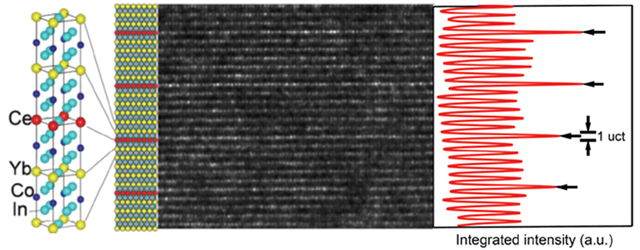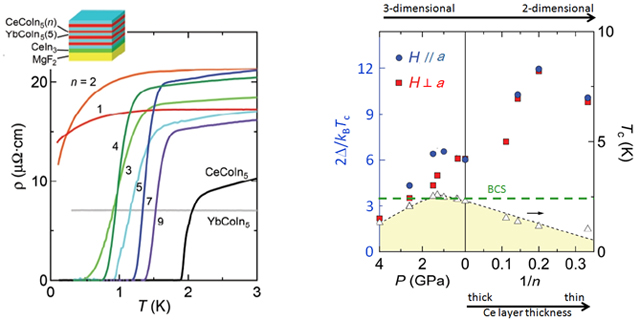October 11, 2011

From left: Assoc. Prof. Shibauchi, Mr. Mizukami,
Prof. Terashima, and Prof. Matsuda.
The ultimately strong electron-electron interaction in metal is realized in the so-called heavy-fermion compound containing rare earth elements, in which the electron effective mass is enhanced by a few hundred times the free electron mass. The group of Yuta Mizukami (Graduate student), Yuji Matsuda (Professor) and Takasada Shibauchi (Associate Professor) in Department of Physics and Takahito Terashima (Professor) in Research Center for Low Temperature and Materials Sciences, has succeeded in achieving the first experimental realization of ‘heavy superconducting electrons’ in a two-dimensional lattice, which were obtained by fabricating heterostructures unavailable in nature. Superlattices with heavy-fermion CeCoIn5 and nonmagnetic YbCoIn5 layers are grown alternately by the molecular-beam-epitaxy technique (Fig. 1). Superconductivity is observed even in superlattice with one-unit-cell thick CeCoIn5 layers, demonstrating a heavy-electron superconductivity with purely two-dimensional electron correlations. Most remarkably, the superconductivity in superlattices persists under significantly higher reduced magnetic fields than in the bulk, implying that the force ("glue") holding together the superconducting electron pairs takes on an extremely strong coupled nature as a result of two-dimensionalization (Fig. 2) -- a situation reminiscent of the high-Tc cuprates.

- Fig. 1: Transmission elctron microscope image of the superlattice of alternating layers of one unit-cell-thick magnetic CeCoIn5 and five unit-cell-thick nonmagnetic YbCoIn5.

- Fig. 2: Superconducting properties of CeCoIn5/YbCoIn5 superlattices. Left: Temperature dependence of the resistivity. n is the number of CeCoIn5 layers. Right: Thickness dependence of the superconducting transition temperature and the superconducting coupling strength, represented by 2Δ/kBTc. In most superconductors, the 2Δ/kBTc value is close to 3.5.
Acknowledgements: This work was supported by KAKENHI from JSPS and MEXT and by Grant-in-Aid for the Global COE program ``The Next Generation of Physics, Spun from Universality and Emergence" from MEXT.
The article, " Extremely strong coupling superconductivity in artificial two-dimensional Kondo lattices " by Y. Mizukami, H. Shishido, T. Shibauchi, M. Shimozawa, S. Yasumoto, D. Watanabe, M.Yamashita, H. Ikeda, T. Terashima, H. Kontani, Y. Matsuda was published in Nature Physics.
Published online 09 October 2011. DOI:10.1038/nphys2112
Link to the journal paper: http://dx.doi.org/10.1038/nphys2112

